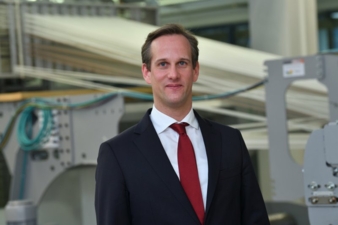18/03/2019 – Speedfactories, storefactories and micro-factories — auf Deutsch lesen
What next?
Ten years ago, it was just an utopian dream but now at Techtextil and Texprocess 2019 it is emerging in the shape of several micro-factories.
Live digitalisation, which few businesses will be able to dodge before long, is beginning to make its mark. The direction of travel, the consequences of Industry 4.0 as a powerful productive force in the textile industry, and what the customer has to gain from it were explained by Dr. Yves-Simon Gloy, Executive Scientific Director at the Saxony Textile Research Institute (STFI) in Chemnitz, in conversation with textile network: “Clearly, developments of this kind are the offspring of the present decade; what started as a vague idea at companies such as Adidas, is now winning over more than just the technicians. Customers, too – admittedly in small numbers at present – are attending presentations, such as the one in Berlin recently, and shaking their heads in disbelief as they watch the digitally networked machinery produce their personalised designs for, say, pullovers or footwear uppers, on site, in little over fifteen minutes.”
Producing locally to the customer
Textile machinery engineer Yves-Simon Gloy was a PhD student at the Aachen Textile Institute when in 2012/13 – encouraged by the sports goods manufacturer – the first steps were taken into the new world of 4.0 with the Speedfactory. Three or four years later, again with the aid of textile researchers at Aachen, the first German Storefactory was conceived for Adidas in Berlin. True technological wonders are brought about in just seven steps – from the 3D scan and creation of the avatar to online image consulting, shopping and knitting of the selected model. “We’re seeking to demonstrate that at this high-tech level, production no longer has to take place in the Far East but can actually be in the customer’s back yard again – quickly, individually and without elaborate logistics that stretch half way around the globe.”
Fully digital and networked processes
Anyone who has ever seen this fully digital, networked process – for example, at the world's first textile Digital Capability Centre, created in a collaboration between McKinsey, the ITA Academy and software provider PTC – senses that this technology will change more than just textile machinery engineering over the next ten years. With a view to a return to decentralised and increasingly regional or even local circular economies, Dr Gloy reckons there is real opportunity for growth among suppliers of such system technology.
3D printing, for instance, is enabling the traditional production stages associated with conventional machine technology to be bypassed. Such machine networks, aimed at batch sizes many times smaller than those required for mass production, are involving the local customer in a new way, he says: small, personally designed volumes, tailored to fit, quickly and sustainably produced, are the result.
“There is one massive challenge to be overcome, though: the cost of batch size 1 is still between a hundred and a thousand times too high...”.
Gloy has been head of research at STFI, which manages the futureTEX consortium, for just over a year; despite a number of typical SME-related problems and challenges regarding digitalisation of the industry, he sees 4.0 structures including micro-factories as being within the scope of smaller local businesses as well. “With the aid of futureTEX, we are aiming to lend a long-term hand to just such textile companies, above all with local solutions from fields such as 3D printing and robotics, and to implement application systems in a practical manner.” In this way, Dr Gloy emphasises, futureTEX can become an incubator for sustainable structures within interested businesses even after the consortium’s funding expires.
How do micro-factories work in the textile sector? Visitors to Texprocess 2019 will be given a detailed insight into this key topic of the trade fair in just a few hours, at four networked production lines.
Shown in more detail than ever before!
1: The Digital Textile Micro-Factory, which is being constructed by the DITF institutes with partners from industry from the Main region of Germany, consists of three lines, on which clothing, 3D-knitted footwear and techno-textile equipment are manufactured. In the case of the fashion line, the customer directly influences the design in real time. This direct interaction between 3D simulations of the clothing, its representation in VR/AR on the customer's hardware, and direct production has never been shown this way before.
Interactive smart cushions
2. The Institute of Textile Technology (ITA) at RWTH Aachen University shows how a novel type of cushion fitted with LEDs, with all kinds of interactive possibilities, is produced in a smart textiles micro-factory. One of the participating partners is from South Korea.
World of Digital Fashion
3. Six businesses have been brought together under this slogan, covering the fields of visualisation, CAD cutting systems, automated body measurement and tailoring and process automation. The focus is on customising clothing and fashion.
Individually designed jerseys
4. The micro-factory from the manufacturers of sewing machine motors (Efka) and CAD solutions (Gemini) focuses on a part-automated entry-level solution for sewing production, which many businesses could incorporate into the technology that they already have available. It produces jerseys that can include personalised designs.
To be seen at the Techtextil + Texprocess (14 to 17 May in Frankfurt am Main) in Halls 4.0 and 4.1
Hans-Werner Oertel





